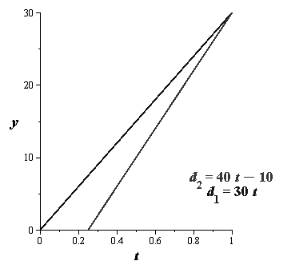
(a)
The system of linear equations that represents distance as the function of time for the buses.
(a)
Answer to Problem 10PS
The system of equation representing the distance as a function of time for each bus is
Explanation of Solution
Given:
The first bus scheduled at 9:00 AM leaves for the airport travelling at 30 miles per hour.The second bus scheduled at 9:15AM leaves for the airport travelling at 30 miles per hour.
Calculation:
Suppose a hotel 35 miles from an airport runs a shuttle service to and from the airport.The first bus scheduled at 9:00 AM leaves for the airport travelling at 30 miles per hour.The second bus scheduled at 9:15AM leaves for the airport travelling at 30 miles per hour.
The distance as a function time for the first bus is
The distance as a function time for the second bus is
Thus, the system of equation representing the distance as a function of time for each bus is
Conclusion:
Thus, the system of equation representing the distance as a function of time for each bus is
(b)
The graph of the equation
(b)
Answer to Problem 10PS
The equation is
Explanation of Solution
Given:
The graph of the equation
Use MAPLE to plot the graph of the above two equations. The two equations are
The plots of the above two equations are shown below

The graph increases and reaches the stable value at particular point.
Conclusion:
The graph increases and reaches the stable value at particular point.
(c)
The distance from the airport will the 9.15A.M bus catch up to the 9.00A.M bus.
(c)
Answer to Problem 10PS
The buses meet at a distance 5miles from the airport
Explanation of Solution
Given:
The distance from the airport will the 9.15A.M bus catch up to the 9.00A.M bus.
Formula used:
The substitution method is used.
Calculation:
When the 9AM bus catches up with the 9:15AM bus, then
When
Thus, the buses meet at a distance 5miles from the airport.
Conclusion:
The buses meet at a distance 5miles from the airport.
Chapter 7 Solutions
EBK PRECALCULUS W/LIMITS
- Pls help ASAParrow_forward9. a) Determie values of a and b so that the function is continuous. ax - 2b f(x) 2 x≤-2 -2x+a, x ≥2 \-ax² - bx + 1, −2 < x < 2) 9b) Consider f(x): = 2x²+x-3 x-b and determine all the values of b such that f(x) does not have a vertical asymptote. Show work.arrow_forwardPls help ASAParrow_forward
- 3. True False. If false create functions that prove it is false. Note: f(x) = g(x). a) If_lim ƒ(x) = ∞ and_lim g(x) = ∞,then_lim [ƒ(x) − g(x)] = 0 x→ 0+ x→0+ x→0+ b) If h(x) and g(x) are continuous at x = c, and if h(c) > 0 and g(c) = 0, then h(x) lim. will = x→c g(x) c) If lim f(x) = 0 and lim g(x) = 0 then lim f(x) does not exist. x-a x-a x→a g(x)arrow_forwardPls help ASAParrow_forward15. a) Consider f(x) = x-1 3x+2 and use the difference quotient to determine the simplified expression in terms of x, for the slope of any tangent to y = f(x). Also, determine the slope at x = 2. 15 b) Determine the equation of the tangent to f(x) at x = 2. Final answer in Standard Form Ax + By + C = 0, A ≥ 0, with no fractions or decimals.arrow_forward
 Calculus: Early TranscendentalsCalculusISBN:9781285741550Author:James StewartPublisher:Cengage Learning
Calculus: Early TranscendentalsCalculusISBN:9781285741550Author:James StewartPublisher:Cengage Learning Thomas' Calculus (14th Edition)CalculusISBN:9780134438986Author:Joel R. Hass, Christopher E. Heil, Maurice D. WeirPublisher:PEARSON
Thomas' Calculus (14th Edition)CalculusISBN:9780134438986Author:Joel R. Hass, Christopher E. Heil, Maurice D. WeirPublisher:PEARSON Calculus: Early Transcendentals (3rd Edition)CalculusISBN:9780134763644Author:William L. Briggs, Lyle Cochran, Bernard Gillett, Eric SchulzPublisher:PEARSON
Calculus: Early Transcendentals (3rd Edition)CalculusISBN:9780134763644Author:William L. Briggs, Lyle Cochran, Bernard Gillett, Eric SchulzPublisher:PEARSON Calculus: Early TranscendentalsCalculusISBN:9781319050740Author:Jon Rogawski, Colin Adams, Robert FranzosaPublisher:W. H. Freeman
Calculus: Early TranscendentalsCalculusISBN:9781319050740Author:Jon Rogawski, Colin Adams, Robert FranzosaPublisher:W. H. Freeman
 Calculus: Early Transcendental FunctionsCalculusISBN:9781337552516Author:Ron Larson, Bruce H. EdwardsPublisher:Cengage Learning
Calculus: Early Transcendental FunctionsCalculusISBN:9781337552516Author:Ron Larson, Bruce H. EdwardsPublisher:Cengage Learning





